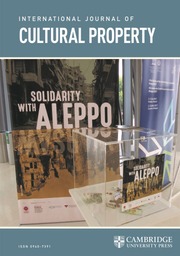No CrossRef data available.
Article contents
Sovereign Objects: International Dimensions of Indigenous Repatriation in Canada
Published online by Cambridge University Press: 28 March 2025
Abstract
“Sovereign Objects: International Dimensions of Indigenous Repatriation in Canada” explores the complexities of cultural repatriation in Canadian museums, advocating for its recognition as an international issue. By framing repatriation this way, the study acknowledges Indigenous sovereignty and aligns with international legal standards such as the United Nations Declaration on the Rights of Indigenous Peoples (UNDRIP). The international approach enhances political, social, and cultural outcomes for First Nations peoples, providing a robust legal framework and fostering greater recognition of Indigenous nations as sovereign entities. The manuscript highlights the importance of acknowledging the distinct cultural and political status of Indigenous communities, supported by historical treaties and contemporary legal recognition. It provides case studies, such as the repatriation of human remains from the Royal Ontario Museum to the Rainy River First Nations, to illustrate the practical application of these principles. The study also critically examines the challenges of adopting the discourse of “nations,” including the technical, political, social, and cultural expectations involved. By redefining repatriation as an international issue, this research promotes a deeper understanding of Indigenous sovereignty and facilitates more effective and culturally sensitive repatriation efforts. The manuscript argues that such an approach is essential for ensuring that repatriation processes are respectful, equitable, and aligned with the unique governance structures of Indigenous communities.
- Type
- Article
- Information
- Copyright
- © The Author(s), 2025. Published by Cambridge University Press on behalf of International Cultural Property Society



